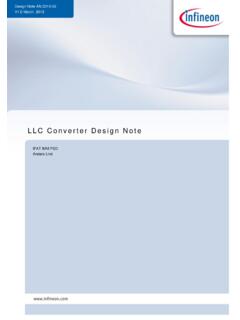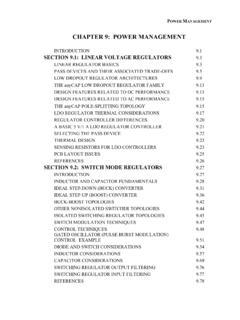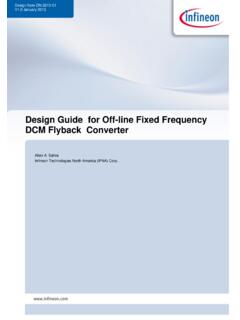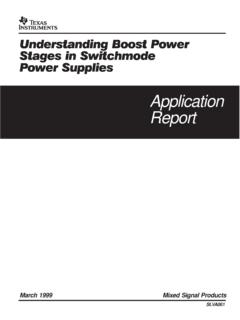Transcription of A Designer’s Guide to Instrumentation Amplifiers, 3rd Edition
1 A designer s Guide to Instrumentation Amplifiers3RD A designer S Guide TOINSTRUMENTATION AMPLIFIERSbyCharles Kitchin and Lew Counts3RD Edition All rights reserved. This publication, or parts thereof, may not be reproduced in any form without permission of the copyright furnished by Analog Devices, Inc. is believed to be accurate and reliable. However, no responsibility is assumed by Analog Devices, Inc. for its Devices, Inc. makes no representation that the interconnec-tion of its circuits as described herein will not infringe on existing or future patent rights, nor do the descriptions contained herein imply the granting of licenses to make, use, or sell equipment constructed in accordance and prices are subject to change without notice.
2 2006 Analog Devices, Inc. Printed in the (B) TABLE OF CONTENTSCHAPTER I IN-AMP BASICS ..1-1 InTroDUcTIon ..1-1In-AMPS vs. oP AMPS: WHAT ArE THE DIFFErEncES? ..1-1 Signal Amplification and common-Mode rejection ..1-1 common-Mode rejection: op Amp vs. In-Amp ..1-3 DIFFErEncE AMPlIFIErS ..1-5 WHErE ArE In-AMPS AnD DIFFErEncE AMPS USED? ..1-5 Data Acquisition ..1-5 Medical Instrumentation ..1-6 Monitor and control Electronics ..1-6 Software-Programmable Applications ..1-6 Audio Applications ..1-6 High Speed Signal conditioning ..1-6 Video Applications ..1-6 Power control Applications.
3 1-6In-AMPS: An EXTErnAl VIEW ..1-6 WHAT oTHEr ProPErTIES DEFInE A HIGH QUAlITY In-AMP? ..1-7 High Ac (and Dc) common-Mode rejection ..1-7 low offset Voltage and offset Voltage Drift ..1-7 A Matched, High Input Impedance ..1-8 low Input Bias and offset current Errors ..1-8 low noise ..1-8 low nonlinearity ..1-8 Simple Gain Selection ..1-8 Adequate Bandwidth ..1-8 Differential to Single-Ended conversion ..1-9 rail-to-rail Input and output Swing ..1-9 Power vs. Bandwidth, Slew rate, and noise ..1-9 CHAPTER II INSIDE AN Instrumentation amplifier ..2-1 A Simple op Amp Subtractor Provides an In-Amp Function.
4 2-1 Improving the Simple Subtractor with Input Buffering ..2-1 The 3-op Amp In-Amp ..2-2 3-op Amp In-Amp Design considerations ..2-3 The Basic 2-op Amp Instrumentation amplifier ..2-4 2-op Amp In-Amps common-Mode Design considerations for Single-Supply operation ..2-5 CHAPTER III MONOLITHIC Instrumentation AMPLIFIERS ..3-1 ADVAnTAGES oVEr oP AMP In-AMPS ..3-1 Which to Use an In-Amp or a Diff Amp? ..3-1 MonolITHIc In-AMP DESIGn THE InSIDE STorY High Performance In-Amps ..3-2 low cost In-Amps ..3-5 Pin-Programmable, Precise Gain In-Amps ..3-6 Auto-Zeroing Instrumentation Amplifiers.
5 3-8 Fixed Gain (low Drift) In-Amps ..3-16 Monolithic In-Amps optimized for Single-Supply operation ..3-17 low Power, Single-Supply In-Amps ..3-19 Gain-Programmable In-Amps ..3-20 CHAPTER IV MONOLITHIC DIFFERENCE AMPLIFIERS ..4-1 Difference (Subtractor) amplifier Products ..4-1 AD8205 Difference amplifier ..4-3 v Gain Adjustment ..4-6 High Frequency Differential receiver/Amplifiers ..4-9 CHAPTER V APPLYING IN-AMPS EFFECTIVELY ..5-1 Dual-Supply operation ..5-1 Single-Supply operation ..5-1 The need for True r-r Devices in low Voltage, Single-Supply IA circuits.
6 5-1 Power Supply Bypassing, Decoupling, and Stability Issues ..5-1 THE IMPorTAncE oF An InPUT GroUnD rETUrn ..5-2 Providing Adequate Input and output Swing ( Headroom ) When Ac coupling a Single-Supply In-Amp ..5-3 Selecting and Matching rc coupling components ..5-3 Properly Driving an In-Amp s reference Input ..5-4cABlE TErMInATIon ..5-5 InPUT ProTEcTIon BASIcS For ADI In-AMPS ..5-5 Input Protection from ESD and Dc overload ..5-5 Adding External Protection Diodes ..5-8 ESD and Transient overload Protection ..5-9 DESIGn ISSUES AFFEcTInG Dc AccUrAcY ..5-9 Designing for the lowest Possible offset Voltage Drift.
7 5-9 Designing for the lowest Possible Gain Drift ..5-9 Practical Solutions ..5-11 Option 1: Use a Better Quality Gain Resistor ..5-11 Option 2: Use a Fixed-Gain In-Amp ..5-11rTI AnD rTo ErrorS ..5-11 Offset Error ..5-12 Noise Errors ..5-12rEDUcInG rFI rEcTIFIcATIon ErrorS In In-AMP cIrcUITS ..5-12 Designing Practical rFI Filters ..5-12 Selecting rFI Input Filter component Values Using a cookbook Approach ..5-14 Specific Design Examples ..5-15 An RFI Circuit for AD620 Series In-Amps ..5-15 An RFI Circuit for Micropower In-Amps ..5-15 An RFI Filter for the AD623 In-Amp.
8 5-16 AD8225 RFI Filter Circuit ..5-16An rFI FIlTEr For THE AD8555 SEnSor amplifier ..5-17 In-Amps with on-chip EMI/rFI Filtering ..5-17 common-Mode Filters Using X2Y capacitors ..5-19 Using Common-Mode RF Chokes for In-Amp RFI Filters ..5-20rFI TESTInG ..5-21 USInG loW-PASS FIlTErInG To IMProVE SIGnAl-To-noISE rATIo ..5-21 EXTErnAl cMr AnD SETTlInG TIME ADJUSTMEnTS ..5-23 CHAPTER VI IN-AMP AND DIFF AMP APPLICATIONS CIRCUITS ..6-1 A True Differential output In-Amp circuit ..6-1 DIFFErEncE amplifier MEASUrES HIGH VolTAGES ..6-1 Precision current Source ..6-3 Integrator for PID loop.
9 6-3 composite In-Amp circuit Has Excellent High Frequency cMr ..6-3 STrAIn GAGE MEASUrEMEnT USInG An Ac EXcITATIon ..6-5 APPlIcATIonS oF THE AD628 PrEcISIon GAIn Block ..6-6 Why Use a Gain Block Ic? ..6-6 Standard Differential Input ADc Buffer circuit with Single-Pole lP Filter ..6-6 changing the output Scale Factor ..6-7v Using an External resistor to operate the AD628 at Gains Below ..6-7 Differential Input circuit with 2-Pole low-Pass Filtering ..6-8 Using the AD628 to create Precision Gain Blocks ..6-9 operating the AD628 as a +10 or 10 Precision Gain Block.
10 6-9 operating the AD628 at a Precision Gain of +11 ..6-10 operating the AD628 at a Precision Gain of +1 ..6-10 Increased BW Gain Block of Using Feedforward ..6-11cUrrEnT TrAnSMITTEr rEJEcTS GroUnD noISE ..6-12 HIGH lEVEl ADc InTErFAcE ..6-13A HIGH SPEED nonInVErTInG SUMMInG amplifier ..6-15 HIGH VolTAGE MonITor ..6-16 PrEcISIon 48 V BUS MonITor ..6-17 HIGH-SIDE cUrrEnT SEnSE WITH A loW-SIDE SWITcH ..6-18 HIGH-SIDE cUrrEnT SEnSE WITH A HIGH-SIDE SWITcH ..6-19 Motor control ..6-19 BrIDGE APPlIcATIonS ..6-19 A classic Bridge circuit ..6-19 A Single-Supply Data Acquisition System.















